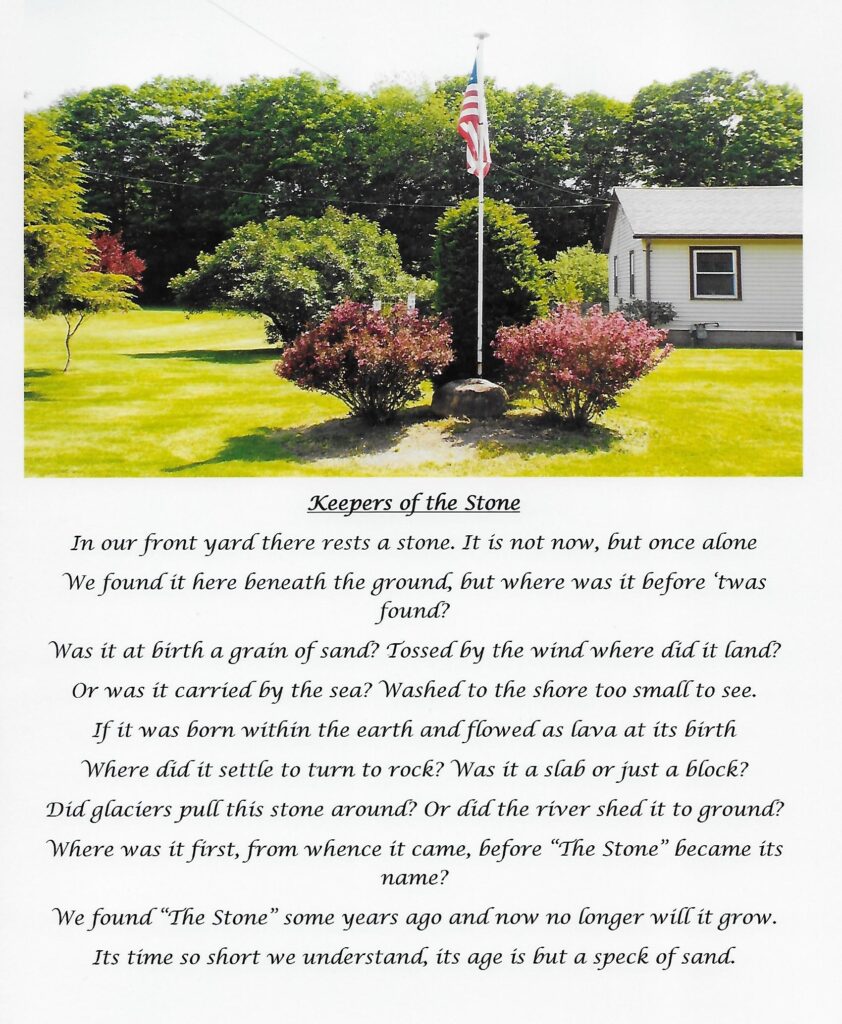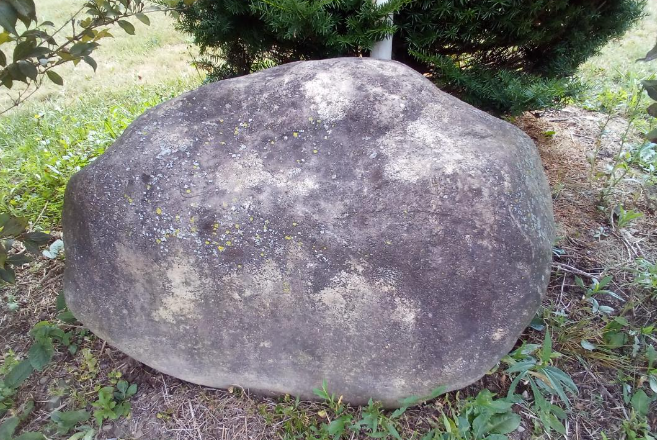I write the words to share what my eyes see and my heart feels
This article has been quite some time in its development and writing. Several months ago, while taking a picture of the centerpiece of our front yard, the thought passed through my mind that the story about the The Stone, which is the focal point of the landscaping, might be of some interest. In our travels I often see similar such adornments in other people’s yards, such as the one just past the cemetery as you get to the foot of the hill going into Friendship on Cty. Rte 31. The owner, a former Friendship Central School classmate, probably wouldn’t mind sharing his name but you can read the name on their “Rock” if you like.
I will end this piece (eventually) with my latest poem “Keepers of the Stone”, which I just finished, and which is primarily the reason for the delayed writing of this column. Despite many starts and stops, I just couldn’t find the words that felt right to poetically paint the picture of the large rock.
I can’t resist a teaching moment, so first just a little about how rocks are formed, thanks to a National Geographics information search. There are three main types of rocks: Sedimentary, Igneous, and Metamorphic. Each of these rock types are formed by physical changes, such as: melting, cooling, eroding, compacting, or deforming which form the “rock cycle”. In rock formation, time “isn’t of the essence”, except in a reversal of the normal meaning of that phrase. The rock formation can take millions of years, and subsequent “physical shaping” only extends that time.
Sedimentary rocks are formed from pieces of other existing rocks or organic material. There are three separate types of sedimentary rocks; Clastic, like sandstone, are formed by smaller pieces of other rock, Organic, like coal, form from hard biological materials like plants, shells, and bones that are compressed into rock. Chemical, like limestone, halite and flint are formed by chemical precipitation. A “chemical precipitate” is a chemical compound like Calcium Carbonate which is a salt and silica “compound”. When mixed with water for example, the saltwater evaporates and leaves the salt and silica residue.
Clastic and Organic rocks begin with the weathering or breaking down of other rocks through erosion. These fine particles are transported by wind, water, ice, or biological activity. The sediment collects, settles, and compacts into subsequent layers. The lower most layers compact so tightly they become hard rock.
Metamorphic rocks are rocks that have been changed from their original form by immense heat or pressure. There are two forms of Metamorphic rock formations: Foliated and Nonfoliated. Without going into detail this difference is just expressing the orientation of striations within rocks such as with Granite or Mica.
Igneous rocks (Latin derivation of “Fire”) form when molten hot material cools and solidifies. If they are formed within the earth, they are called Intrusive or Plutonic rocks. Since these formed within the earth, having spent thousands or millions of years under intense pressure and gradually cooling down, they have developed larger mineral crystals. Granite and Diorite are examples of this.
Igneous rocks that exit the earth molten as a liquid like lava, are called Extrusive. Since they cool more quickly, they have less time to form crystals. Basalt and Obsidian are examples of this form of rock. Obsidian cools into volcanic glass so quickly that the grains are invisible to the naked eye. Given this relatively quick cooling, gas bubbles are readily trapped and upon solidification gives a “bubbly” internal texture. Pumice is one such material.

Departing the Pre-Historical aspects of rocks, and moving into my own Pre-Hysterical rocky history, I continue not into the Rockies but on a rocky path. In 1992 we decided to add some length to our house so there would be enough room in the kitchen to be able to literally turn around and not run into each other. We had been told that our house had been built on a lot where a small schoolhouse was once located. Given that history, we were not surprised to find an old “ink well”, a couple of smaller, perhaps medicine bottles, and several short lengths of “pencil lead”. These were about 3/16” in diameter and 2 to 3 inches long, and I suspect used as writing utensils, just as they were, without any surrounding wood.
What did surprise us, however, was the unearthing of a several hundred-pound rock. That is a weight “guesstimation” based on my inability to pick it up 😉. The rock measured around two feet in diameter and nearly three feet long. When the contractor asked what we wanted done with the rock, as he sat there with it loaded in the bucket of his payloader, we pointed to the large ditch edging our back yard and said dump it in there. That “ditch”, as I believe I’ve mentioned previously, is the former water channel formed between the old Buffalo and Susquehanna railroad bed and our back lawn. The ditch was used to divert water from the Knights Creek north to form the pond/lake that was part of the old BOANGA Club, now known as the Millstone Farm and Meeting Center (which is currently for sale I believe).
I no longer recall if it was seconds, minutes, or days before realizing that The Stone would make an ideal lawn ornament, but my wife implored me to see if I could get it back up out of the 20-foot-deep ditch. “No problem”, said I, not really believing that myself, “I can pull it up out of there with the jeep.” I fashioned a sling out of ropes and tow straps and wrapped it around The Stone Very carefully and slowly, I dragged it up the bank onto flat terrain. Once up, I pulled it onto a large section of plywood and towed it to the front lawn and, not easily, reoriented it into its present position.
Over the years we have added various plantings and a flagpole and it proudly rests in our front yard standing guard and as a tribute to “the sands of time”.
We will keep The Stone, proudly displayed until our passing and hope it remains visible beyond our years.







